UNIT 1:THE CONCEPT OF INTEGRATED SCIENCE AND MEASUREMENTS OF PHYSICAL QUANTITIES
Key unit competence
Explain the concept of Integrated science and Use appropriate materials to measure different physical quantities.
Introductory Activity ILook carefully at the following illustrations and answer the questions below:

Questions:
a) Describe the illustration A, B, C, D.
b) Based on your knowledge from O-level, what are scientific concepts can you associate to each of those illustrations? Group the noted concepts in their science subject areas.
c) Is there any one illustration in which you find application of many science subjects area? Justify your answer by providing other examples found in everyday life.
d) Can you explain how and why every person should have integrated understanding of those science subject areas?
e) What kind of physical quantities that can be measured in the illustration above? Suggest the names of the tools used in the
illustration above?
f) Outline other examples of physical quantities and the corresponding measuring tools
g) What can be considered to select the best tool(s) to be used in measuring a given measurable quantity?
1.1 Introduction to integrated science
Activity 1.1
Task 1
It is known that an Integrated Science course serves the purpose of unifying sciences in a whole one subject covering both the physical and life sciences. These courses are integrated in that the fields of science are not segmented. For example, in describing the physics of light, we show how this applies to the inner workings of our eyes, which, in turn, are sensitive to visible light in great part because of the chemical composition of our atmosphere.
Use the paragraph above to answer the following questions:
a) What does the term Integrated Science mean?
b) Explain why Integrated Science is very important in finding appropriate solutions in various complex situations? Justify your
answer based on the paragraph above and other examples observed in everyday life.
Task2
Suppose you visited two industries and took the photos below and saw that distinguished science subjects are involved in the process of production. Write a paragraph about your visit identifying how Physics, Biology and Chemistry are integrated in the process.
1.1.1 Definition and rationale of integrated science
Human survival depends on knowledge through the exploration of the environment. Science provides knowledge while technology provides ways of using this knowledge. It is therefore very important to be aware of the global dimension of science needed in our lives in order to effectively deal with every day situation. The word “integrated” means “to restore the whole, to come together, to be a part of, to include.” Integrated science is a subject which incorporates the knowledge base of all the science fields, both physical and life sciences and these science fields are included in one subject as a whole “integrated science” in that the fields of science are not segmented. It is a subject which offers experiences which help people to develop an operational understanding of the structure of science that should enrich their lives and make them more responsible citizens in the society. Hence, integrated approach of learning science is appropriate as science knowledge is a tool to be used by every person to effectively deal with real world problems and life.
For examples, when you are studying digestion process of animals, you will need the knowledge of chemical processes. Another example, in describing the physics of light, we show how this applies to the inner workings of our eyes, which, in turn, are sensitive to visible light in great part because of the chemical composition of our atmosphere.
Aims and Objectives of Integrated Science subject The overall aim of the integrated science subject is to enable students
develop scientific literacy so that students can participate actively in the rapidly changing knowledge based society, prepare for further studies or careers in fields where the knowledge of science will be useful.
However, the broad aims of integrated science subject are to enable students to:
– Develop interest in and maintain a sense of wonder and curiosity about the natural and technological world;
– Acquire a broad and general understanding of key science ideas and explanatory framework of science and appreciate how the ideas were developed and why they are valued;
– Develop skills for making scientific inquiries;
– Develop the ability to think scientifically, critically and creatively and to solve problems individually or collaboratively in science related contexts;
– Use the language of science to communicate ideas and views on science – related issues;
– Make informed decisions and judgments about science related issues;
– Be aware of the social, ethnical, economic, environmental and technological implications of science and develop an attitude of
responsible citizenship; and
– Develop conceptual tools for thinking and making sense of the world.
1.1.2. Interconnection between science subjects
The purpose of science is to produce useful models of reality which are used to advance the development of technology, leading to better quality of life for human being and the environment around him or her.
There are many branches of science and various ways of classifying them.
One of the most common ways is to classify the branches into natural sciences, social sciences, and formal sciences.
Natural sciences: the study of natural phenomena (including cosmological, geological, physical, chemical, and biological factors of the universe).
Natural science can be divided into two main branches: physical science and life science (or biological science). Social sciences: the study of human behavior and societies. The social sciences include, but are not limited to: anthropology, archaeology, communication studies, economics, history, musicology, human geography, jurisprudence, linguistics, political science, psychology, public health, and sociology. Formal science is a branch of science studying formal language disciplines concerned
with formal systems, such as logic, mathematics, statistics, theoretical computer science, artificial intelligence, information theory, game theory, systems theory, decision theory, and theoretical linguistics.
Note:
– Chemistry mainly deals with the study of matter’s properties and behaviors as well as reactions between them to produce new useful products. For a physicist to understand the working mechanism of chemical cells, help is sought from a chemist. On the other hand, the reasons behind the various colours observed in most of the chemical reactions are explained by a physicist. Petroleum products are dealt with by the chemist, but the transportation of such products make use of the principles of physics.
– In Biology, the study of living cells and small insects by a biologist requires magnification. The concept of magnification using simple or compound microscope is a brain child of a physicist. A good physicist needs to have good health.
1.1.3. Relationship between science with other subjects
The concepts of science and other subjects might be expanded or explainable in broader senses than you might have been exposed to, this should then predict not only the interconnection senses already known, but should also predict much broader interconnections. This might be useful to you and our future civilization.
Science is about observation and experimentation of things in the physical and natural world. If there no creative ideas, no destructive ideas, just more ideas of the same things that exist can this be healthy. There is such a thing as inductive reasoning not just deductive reasoning.
Now, science is the practical application of scientific knowledge. So we could have science as a conservative subject, or we could have science as a creative (conservative and destructive) subject, then leading to smaller or larger sets of science.
Note:
– In Geography, weather forecast, a geographer uses a barometer, wind gauge, etc. which are instruments developed by a physicist.
– In Agriculture, the water sprinkler, insecticide sprayer, etc. make use of the principles developed by physicists.
– In History, the determination of age fossils by historians and archaeologists use the principle developed by physicists.
– In games and sports, accurate measurement of time, distance, mass, and others uses instruments developed by physicists.
Application activity 1.1
1. Write a paragraph to convince someone that science is related to other subjects. Use clear examples to support your arguments and reasoning.
2. How can you describe the interconnections between science and technology, using at least three specific examples?
1.2 Measurements of physical quantities.
Activity 1.2
Task 1:
Look around the place and identify possiple physical quantities that can be measured? Explain the meaning of the physical quantities you have identified? Mention the SI units of the identified physical quantities?
Task 2:
It is possible to determine the nature and magnitude of the physical quantities that are measurable. Which of the following situations can be determined with the guidance of measurements? Support your answer with explanations and mention the physical quantity to be measured if possible.
a) Love between a boy and girl.
b) Size of the body.
c) Size of the garden?
d) Amount occupied by water in a tank.
1.2.1 Physical quantities and their measurements.
A quantity is any observable property or process in nature with which a number may be associated.
A physical quantity is defined as a property of a material that can be quantified by measurement.
Physical quantities are classified into fundamental and derived quantities.
FUNDAMENTAL PHYSICAL QUANTITIES
A quantity may be defined as any observable property or process in nature with which a number may be associated. This number is obtained by the operation of measurements. The number may be obtained directly by a single measurement or indirectly, say for example, by multiplying together two numbers obtained in separate operations of measurement. Fundamental quantities are those quantities that are not defined in terms of other quantities.
In physics there are 7 fundamental quantities of measurements namely length, mass, time, temperature, electric current, amount of substance and luminous intensity.
• DERIVED PHYSICAL QUANTITIES
Quantities which are defined in terms of the fundamental quantities via a system of quantity equations are called derived quantities. Examples of derived quantities include area, volume, velocity, acceleration, density, weight and force.
The SI units of derived quantities are obtained from equations using mathematical expressions
Note that some derived units have been given names. For example, force is measured in kg m/s2 and has been given a named unit called a newton (N).
1.2.2 International system of units
In order to measure any quantity, a standard unit (base unit) of reference is chosen. The standard unit chosen must be unchangeable, always reproducible and not subject to either the effect of aging and deterioration or possible destruction.
In 1960, an international system of units was established. This system is called the International System of Units (SI).
The International System of Units is an internationally agreed metric system of units of measurement. SI base quantities and units: The value of a physical quantity is usually expressed as the product of a number and a unit.

Name, Symbol and factor of metric prefixes in everyday use at workplace.SI prefixes used to form decimal multiples and submultiples of S I units (table 2 below). Table 2: SI prefixes
Example for length
• 10 mm= 1cm
• 1m= 106μm
• 1m=10-9Gm
• 1m2=(1012pm)2=1024pm2
Note: Numbers in the SI system are based on the number 10. Units in the SI system can therefore be multiplied or divided by 10 to form larger or smaller units.
1.2.3 Measuring fundamental physical quantities
• MEASURING LENGTH AND DISTANCE
We use different tools for measuring length: metre rule, ruler, tape measure, vernier caliper and the micrometer screw gauge based on the kind of length to measure. Straight distances that are less than one metre in length are generally measured using metre rules. Straight distances that are more than one metre in length are generally measured using tape measure.
A tape measure or measuring tape is a flexible ruler and used to measure distance. A tape measure is in form of a strip of metal, plastic or cloth that has numbers marked on it as shown in figure below and is used for measuring.
The figure below represents examples of tape measures:

It is a common measuring tool purposely designed to allow for a measure of great length to be easily carried out and permits one to measure around curves or corners. Surveyors use tape measures in lengths of over 100 m.
Metre rules are graduated in millimetres (mm). Each division on the scale represents 1 mm unit (Fig 1.3).

The direct way to measure length is by means of the straight edge of a ruler or metre ruler. The ruler is placed alongside the object to be measured, and the number of unit intervals of the ruler equal to the length of the object is then noted.
Metre rule is used to measure lengths up to about 100 cm and has a sensitivity of 0.5 mm.
Vernier caliper is an instrument used to measure outer dimensions of objects inside dimensions and depths. The figure below shows the vernier calipers:
We can measure outer dimensions of objects (using the main jaws), inside dimensions (using the smaller jaws at the top), and depths (using the stem).
The vernier calipers have a main scale and a sliding vernier scale that can allow readings to the nearest 0.02 mm. To measure outer dimensions of an object, the object is placed between the jaws, which are then moved together until they secure the object.
The screw clamp may then be tightened to ensure that the reading does not change while the scale is being read.The first significant figures are read immediately to the left of the zero of the vernier scale and the remaining digits are taken as the vernier scale division that lines up with any main scale division.
The internal diameter of the test tube is given by MSR + (VC × LC) Whereby the main scale reading (MSR), the vernier coincidence (VC).and The smallest reading called the least count (LC) that can be read from vernier callipers is 1 mm – 0.9 mm = 0.1 mm or 0.01 cm .
The main scale called the vernier coincidence (VC) and multiplying it with the least count i.e 0.01 cm.Therefore, the external diameter of the cylindrical object is MSR + (VC × LC)
A micrometer screw gauge is an instrument for measuring very short length such as the diameters of wires, thin rods, and thickness of a paper. Figure below shows a screw gauge:
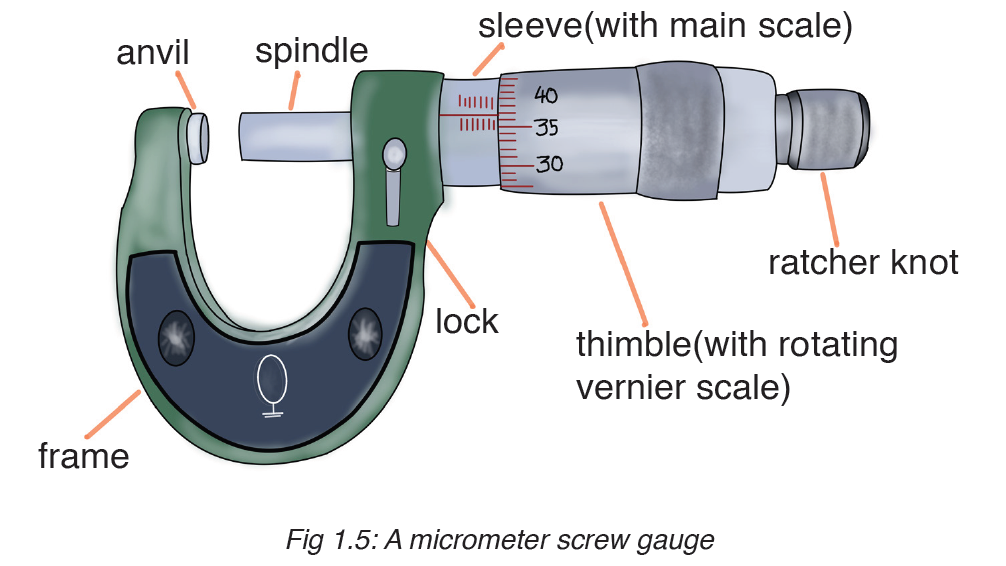
The micrometers have a pitch of 0.50 mm (two full turns are required to close the jaws by 1.00 mm). The rotating thimble is subdivided into 50 equal divisions. The thimble passes through a frame that carries a millimetre scale graduated to 0.5 mm. Thimble, which has a circular rotating scale that is calibrated from 0 to either 50 or 100 divisions. This scale is called the head
scale (thimble scale).
When the thimble is rotated, the spindle can move either forward or backwards. Ratchet which prevents the operator from exerting too much pressure on the object to be measured.The least count = 0.01 mm. The micrometer screw gauge reading = MSR + (HSC × LC). When the pitch is 1 mm, the thimble has 100 divisions called head scale divisions. In this case each division represents 0.01 mm. This is the least count (LC) of this screw gauge.
The thimble reading called the head scale coincidence(HSC) is the value of the mark on the thimble that coincides with the horizontal line on the sleeve.
Main scale reading is taken by considering the reading of a mark on the fixed scale that is immediately before the sleeve enters the rim of the head scale.
The jaws can be adjusted by rotating the thimble using the small ratchet knob. This includes a friction clutch which prevents too much tension being applied. The thimble must be rotated through two revolutions to open the jaws by 1 mm.
In order to measure an object, the object is placed between the jaws and the thimble is rotated using the ratchet until the object is secured. The ratchet knob must be used to secure the object firmly between the jaws, otherwise the instrument could be damaged or give an inconsistent reading.The lock may be used to ensure that the thimble does not rotate while you take the
reading.
• MEASURING MASS
The mass of an object can be measured using a beam balance and a set of standard masses. It is noticed that the volume of the displaced water in measuring cylinder is equal to volume of an object lowered in the cylinder.
There are many kinds of balances used for measuring mass illustrated below:

• MEASURING TIME
Time is measured using either analogue or digital watches and clocks and illustrated in figure below:
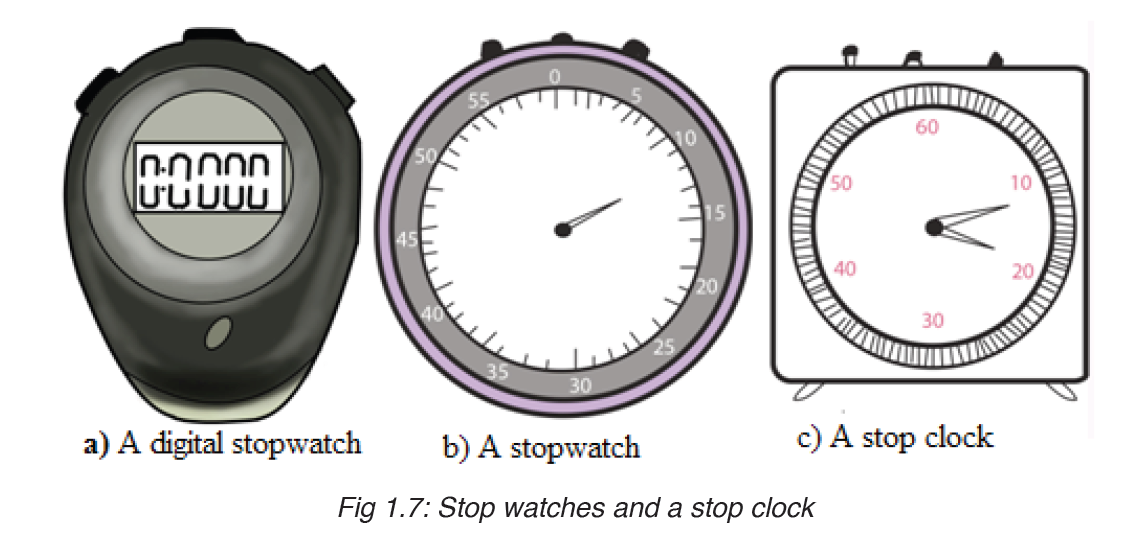
Application activity 1.2
1.Mention the appropriate instruments you would use to measure each of the following:
a) The The mass of an object.
b) The circumference of your waist.
c) The time someone uses to cover a certain length.
d) The diameter of a small ball.
2. It is possible to read and record the readings using a scale of a vernier caliper in order to measure the external diameter of the rod.
Steps followed in using vernier
a. Place the object to be measured between the outside jaws as shown in Figure below. Slide the jaw until they touch the rod.

b. Record the readings on the main scale and the vernier scale. The main scale reading is the mark on the main scale that is immediately before the zero mark of the vernier scale.
c. Multiply the vernier scale reading by 0.01 cm.
d. Add the main scale reading (in cm) and the vernier scale reading (in cm) to get the diameter of the rod.
3. What is the diameter of the ball bearing shown in Figure below?
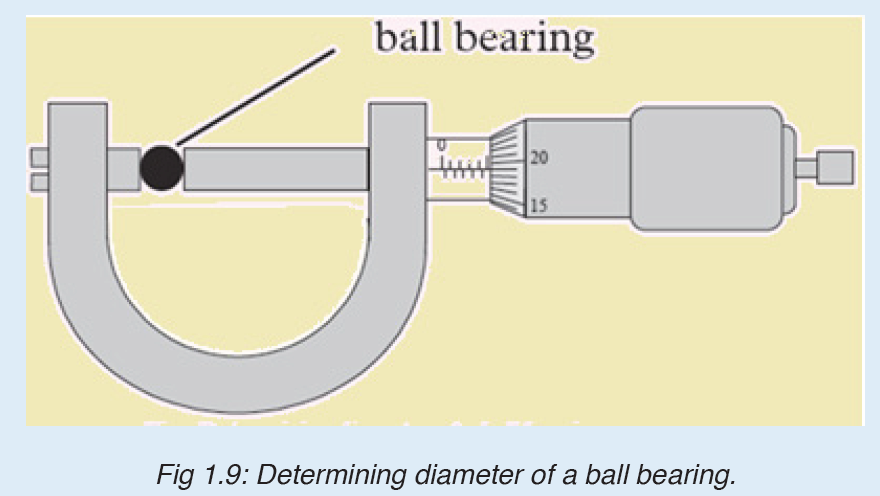
4.a) What does S I Units stands for?
b) Explain why it is correct to say that SI units are very important in measurements?
c) Suppose you wish to know the length of a big garden. How do you get the length of your garden?
d) Look at the following physical quantities: Mass, density, length, and time. Do all these quantities represent the fundamental quantities?
Justify your decision by identifying the ones included in the category mentioned above.
5. Look at the table below and try to complete it based on the skills gained in the previous activities done;
6. Choose two physical quantities with which you are familiar. Imagine that you are skilled in physical quantities and its measurements. Explain briefly how the values of these quantities can be obtained?
7. Express the following the indicated units and fill in blank spaces:
a) 250 m in …..cm.
b) 320 mg in ……g.
c) 5μg in ………g.
d) 7200 cm in …..m.
e) 3 kg in ……… g.
1.3 Dimensions of physical quantities
Activity 1.3
Given the formulas for the following derived quantities, try go get the dimensions of each quantity.
a) velocity = displacement/time
b) acceleration = change of velocity/time
c) momentum = mass x velocity
d) force = mass x acceleration
e) work = force x displacement
1.3.1 Introduction to dimensions of physical quantities
The nature of physical quantity is described by nature of its dimensions.
When we observe an object, the first thing we notice is the dimensions.
In fact, we are also defined or observed with respect to our dimensions that is, height, weight, the amount of flesh. The dimension of a body means how it is relatable in terms of base quantities. When we define the dimension of a quantity, we generally define its identity and existence. It becomes clear that everything in the universe has dimension, thereby it has presence.
Note: Dimensions are responsible in defining shape of an object.
1.3.2 Definition of dimensions of physical quantities
The dimension of a physical quantity is defined as the powers to which the fundamental quantities are raised in order to represent that quantity. The seven fundamental quantities are enclosed in square brackets [ ] to represent its dimensions.
• EXAMPLES OF ASSIGNING DIMENSIONS TO PHYSICAL QUANTITIES
Dimension of Length is described as [L], the dimension of time is described as [T], the dimension of mass is described as [M], the dimension of electric current is described as [A] and dimension of the amount of quantity can be described as [mol].Adding further dimension of temperature is [K] and that dimension of luminous intensity is [Cd] Consider a physical quantity Q which depends on base quantities like length, mass, time, electric current, the amount of substance and temperature, when they are raised to powers a, b, c, d, e, and f. Then dimensions of physical quantity Q can be given as:
[Q] = [LaMbTcAdmoleKf]
It is mandatory for us to use [ ] in order to write dimension of a physical quantity. In real life, everything is written in terms of dimensions of mass, length and time. Look out few examples given below:
1. The volume of a solid is given is the product of length, breadth and its height. Its dimension is given as:
Volume = Length × Breadth × Height
Volume = [L] × [L] × [L] (as length, breadth and height are lengths)
Volume = [L]3
As volume is dependent on mass and time, the powers of time and mass will be zero while expressing its dimensions i.e. [M]0 and [T]0
The final dimension of volume will be [M]0[L]3[T]0 = [M0L3T]
2. In a similar manner, dimensions of area will be [M]0[L]2[T]0
3. Speed of an object is distance covered by it in specific time and is given as:
Speed = Distance/Time
Dimension of Distance = [L]
Dimension of Time = [T]
Dimension of Speed = [L]/[T]
[Speed] = [L][T]-1 = [LT-1] = [M0LT-1]
4. Acceleration of a body is defined as rate of change of velocity with respect to time, its dimensions are given as:
Acceleration = Velocity / Time
Dimension of velocity = [LT-1]
Dimension of time = [T]
Dimension of acceleration will be = [LT-1]/[T]
[Acceleration] = [LT-2] = [M0LT-2]
5. Density of a body is defined as mass per unit volume, and its dimension is given as:
Density = Mass / Volume
Dimension of mass = [M]
Dimension of volume = [L3]
Dimension of density will be = [M] / [L3]
[Density] = [ML-3] or [ML-3T0]
6. Force applied on a body is the product of acceleration and mass of the body
Force = Mass × Acceleration
Dimension of Mass = [M]
Dimension of Acceleration = [LT-2]
Dimension of Force will be = [M] × [LT-2]
[Force] = [MLT-2]
1.3.3 Rules for writing dimensions of a physical quantity
We follow certain rules while expression a physical quantity in terms of dimensions, they are as follows:
– Dimensions are always enclosed in [ ] brackets
– If the body is independent of any fundamental quantity, we take its power to be 0
– When the dimensions are simplified we put all the fundamental quantities with their respective power in single [ ] brackets, for example as in velocity we write [L][T]-1 as [LT-1]
– We always try to get derived quantities in terms of fundamental quantities while writing a dimension.
– Laws of exponents are used while writing dimension of physical quantity so basic requirement is a must thing.
– If the dimension is written as it is we take its power to be 1, which is an understood thing.
– Plane angle and solid angle are dimensionless quantity that is they are independent of fundamental quantities.
– Therefore, some of the examples of dimensions of physical quantities include the following:
Force, [F] = [MLT-2]
Velocity, [v] = [LT-1]
Charge, (q) = [AT]
Specific heat, (s) = [L2T2K-1]
Gas constant, [R] = [ML2T-2K-1 mol-1]
• Benefits of Dimensions
Before writing dimensions of a physical quantity, it is must know a thing to understand why do we need dimensions and what are benefits of writing aphysical quantity. Benefits of describing a physical quantity are as follows:
– Describing dimensions help in understanding the relation between physical quantities and its dependence on base or fundamental quantities, that is, how dimensions of a body rely on mass, time, length, temperature and others.
– Dimensions are used in dimension analysis, where we use them to convert and interchange units.
– Dimensions are used in predicting unknown formulae by just studying how a certain body depends on base quantities and up to which extent.
– It makes measurement and study of physical quantities easier.
– We are able to identify or observe a quantity just because of its dimensions.
– Dimensions define objects and their existence.
Limitations of Dimensions
Besides being a useful quantity, there are many limitations of dimensions, which are as follows:
– Dimensions can’t be used for trigonometric and exponential functions.
– Dimensions never define exact form of a relation.
– We can’t find values of certain constants in physical relations with the help of dimensions.
– A dimensionally correct equation may not be the correct equation always.
• Dimension Table
It consumes a lot of time while deriving dimensions of quantities. So in order to save time, we learn some basic dimensions of certain quantities like velocity, acceleration, and other related derived quantities.
For Example, suppose you’re asked to find dimensions of Force and you remember dimension of acceleration is [LT-2], you can easily state that the dimension of force as [MLT-2] as force is the product of mass and acceleration of a body.
The table below depicts dimensions of several derived quantities which one can use directly in problems of dimension analysis.
Application activity 1.3
1.i. What are four uses of dimensional analysis? Explain with one example for each.
ii. What are three limitations of dimensional analysis in physics?
2. Show that 1/2 gt2 has the same dimensions of distance.
3. What are the missing words in the following statements?
a) The dimensions of velocity are ………………………………. .
b) The dimensions of force are ……………………………………. . .
4.a) What does the term dimension mean in Physical quantities?
b) Given the formulas for the following derived quantities, calculate the dimensions of each quantity.
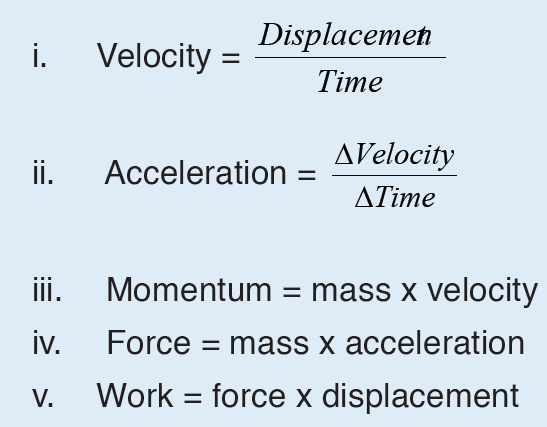
SKILLS LAB
Conduct a survey, collect and analyze data about when, where, and why people use different measuring instruments or devices and physical laws.
To complete this project you must Develop a survey sheet about physical quantities, measuring instruments or devices, physical laws needed, appropriate SI units and metric prefixes used in everyday life.
Distribute your survey sheet to other student-teachers, family members and neighbors.
• Compile and analyze your data.
• Create a report to display your findings in your sheet.
Plan it! To get started, think about the format and content of your survey sheet. Brainstorm what kinds of questions you will ask. Develop a plan for involving student-teachers in your class or other classes to gather more data.
End unit assessment 1
1. Differentiate between a fundamental quantity and a derived quantity.
Give one example of each and its corresponding SI units.
2. Express the following in millimetres:
a) 2.7 m
b) 26.9 cm
c) 356 μm.
3. What is the length of the glass rod shown in Figure below?
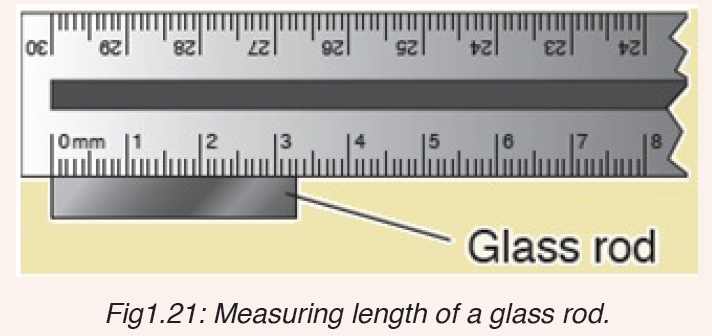
4. Use the knowledge and skills gained from the previous concepts to complete the following sentences:
a) A quantity may be defined as any ………………………. in nature with which a number may be associated.
b) Physical quantities are classified into ……………. .and………………… quantities.
c) ……………………………are those quantities that are not defined in terms of other quantities.
d) The value of a physical quantity is usually expressed as the product of a …………………and a ……………………
e) The SI units stands for ………………………………………………….
5. Kaneza conducted an experiment on the growth of plants and recorded the results in a table. He used four plants of the same type and size and measured their growth after one month.
Fig: Table of results based on each plant type.
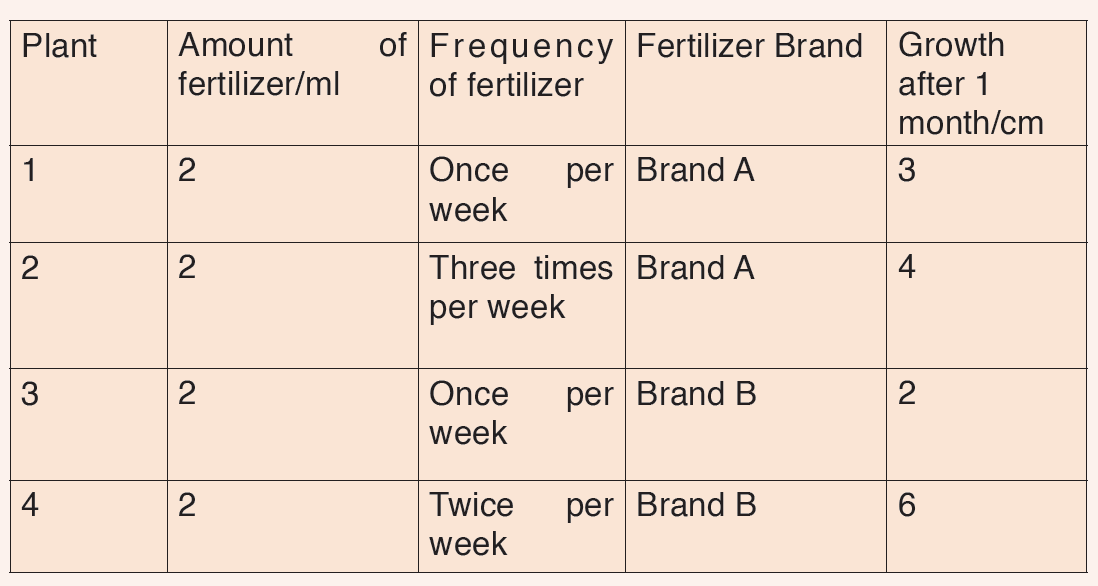
Questions on scientific report above:
a) Identify the possible data types that were considered in Kaneza’s experiment?
b) Tell whether each data type was controlled effectively?
c) Explain what is wrong with Kaneza’s experiment?
d) What could he change to allow better conclusions to be drawn in the scientific investigation above?
